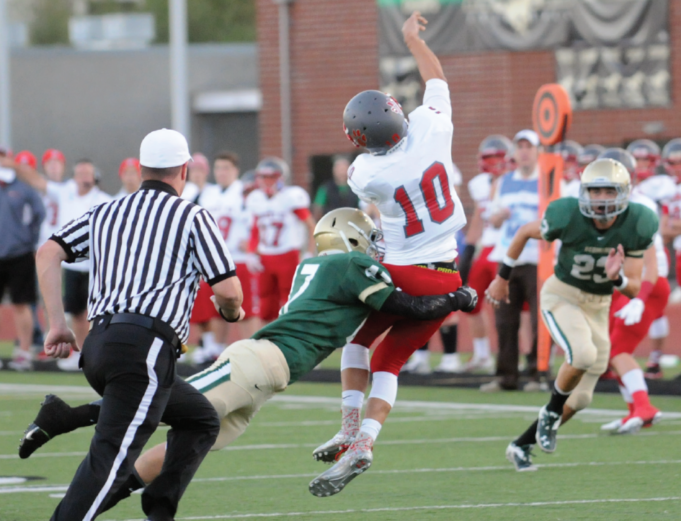Six Elements of Your Officiating Anatomy

REPUBLISHED FROM REFEREE MAGAZINE - 1/1/2023
Officiating requires the use of many body parts and in most cases those parts must coordinate with one another.
The human anatomy is an intricate structure consisting of 11 systems and containing more than 37 trillion cells. Officiating requires the use of many of those body parts and in most cases, those parts must coordinate with one another. Here are 6 elements of your officiating anatomy.
1. Eyes
Almost everyone would likely name the eyes as the body part most important to officiating. A college official who had received good ratings was phased out when it became public knowledge that he had a glass eye. The eyes detect light and convert it into electro-chemical impulses in neurons. Visual acuity is the ability to distinguish fine detail and that’s exactly what’s needed to determine if a restriction has occurred when two linemen are engaged.
Most fouls cannot be called properly unless the whole act is observed. Perhaps the best examples are illegal blocks. To call a block below the waist, the official must see the initial contact. If he doesn’t, the official may not know if the blocker started with legal contact and then slid on the opponent’s body. If the official doesn’t see the initial contact on a potential block in the back, he may not know if the opponent turned on the blocker.
2. Ears
Hearing the sounds of the game is useful, if not essential. There is some benefit to not being able to hear what comes out of the team box, but overall a deaf official would be at a disadvantage. The umpire must know if the defense is interfering with the snap count. Perhaps the most important use of auditory perception is dead-ball officiating.
If opponents linger, officials should move in promptly to address it. When you can’t get to two players who have squared off before they part, go to the guy who is most upset and ask him the nature of the problem. He’ll usually complain of being punched or sworn at. Tell him you’ll take a closer look. If he started it, he knows he’ll be watched. If he didn’t, the foul can usually be spotted the next time. The fact an official is asking for details seems to make all the players aware the officials are tuned in to what’s going on and monitoring it closely.
3. Mouth
The mouth is used for communication, especially with crewmates, and that is an essential part of officiating. However, improper use of the vocal cords has besmirched many an official. “Speak when you are angry, and you’ll make the best speech you’ll ever regret.” Those words are commonly attributed to author Laurence J. Peter, known for The Peter Principle. Coaches can get away with it; officials cannot.
The regretful words can be uttered either during or after the game. As a general rule, the less you say to players, the better off you’ll be. However, some communication is not only necessary but desirable. Building rapport with the participants is part of good officiating. Under no circumstances, though, should officials fraternize, criticize, coach or threaten.
Last season, a local official was admonished because he tried to caution a player by saying, “Don’t be a dumbass.” The player mentioned it to his father, who was an assistant coach and then his mother got in on it and soon there was a controversy.
Some officials have found success appealing to a player’s ego. “You’re too good of a player to act like that” can result in a player calming down.
4. Arms
Like the mouth, the arms are used for communicating. Signals must be clear and be concise. Rushing or dawdling with signals is not very effective. By rushing, you communicate poorly; by dawdling, you keep the game from moving. A common error in signaling is excessive repetitions. In most cases, once is enough and two are acceptable. Recently, a crew from a smaller association received a very poor rating on a playoff game. Upon further review, the crew actually had called a decent game, properly getting forward progress. Apparently, what had turned off the observer was the hunched-over signaling on incomplete passes by the wing officials. Instead of signaling decisively while standing erect, they signaled while moving and waving their arms like ape men.
Some calls need to be sold. Close calls need a little extra emphasis to communicate to everyone clearly. But selling a call is like raising your voice — sometimes it is necessary and effective, but do it too often and people get angry or turned off. Sell a call only when necessary. You don’t want to appear that you’re caught up in the emotion of the game.
In one instance, a runner was ruled down when the ball became loose and was recovered by the defense. In the ensuing confusion, the chains moved and didn’t get back to the correct position and that went unnoticed by the head linesman. The video revealed the head linesman merely signaled the number of the next down while the back judge nonchalantly pointed at the spot where the runner was down. If the call had been properly sold (the video also revealed it was indeed a fumble), the chains likely would not have moved.
5. Legs
To get the call right, an official must get to the proper position. That is what mechanics manuals are all about. In most cases, angle is much more important than distance. That usually requires movement. That includes the back judge on running plays moving as his buffer begins to dissolve to restore his separation while keeping a watchful eye on the runner and the nearest potential tackler, and the referee keeping pace with a quarterback who rolls away and covering the near sideline when the quarterback approaches it.
Beware of overusing your legs, the so-called “false hustle.” That refers to energetic movement during liveball coverage that serves no purpose other than to demonstrate the official can move rapidly. The real problem with false hustle is no officiating is accomplished while the official is showing everyone how fast he can run. When the runner breaks open for a long run, wing officials should focus on the blocking to see if any defender is illegally restrained from catching the runner. Blindly racing to a goalline that will be covered by the back judge may look good but serves no officiating purpose.
6. Brain
The five senses — sight, hearing, smell, taste and touch — are part of the nervous system and collect information about our environment that is interpreted by the brain (the latter three senses are of minimal value to officiating). We utilize that information based on previous experience, subsequent learning and by the combination of the information from each of the senses. Each sense provides different information which is combined and interpreted by our brain. Here is an example.
A player tackles a receiver in a straight line away from the covering official. It appears the tackler first makes contact with his shoulder, but the crack of helmets crashing is clearly heard. The sound should spur the official to reconsider what he saw. If he determines the position of the tackler’s head was consistent with a targeting foul, the flag should be thrown even if helmet contact was not observed.




